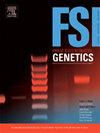Comparison of DNA profiles from samples collected from underneath fingernails and hand deposits following everyday activity
IF 3.1
2区 医学
Q2 GENETICS & HEREDITY
引用次数: 0
Abstract
In instances of direct physical contact between individuals involved in criminal activity, body samples can provide significant and relevant information to aid in criminal investigations and court proceedings. Fingernails are one such forensically relevant body area that is capable of providing evidence of direct contact and potentially revealing whether the interaction involved was of a forceful kind. Several studies have investigated the prevalence of non-self DNA under fingernails after different crime-related scenarios; however, few have assessed the types of DNA profiles found after everyday activities. Furthermore, the comparability of the fingernail samples to those deposited on contacted surfaces remains unknown. In this study, we examined the composition of self- and non-self-DNA in samples collected from under the fingernails and held tubes from the same set of individuals. Additionally, the potential use of fingernails samples for shedder assessment was evaluated through comparison with two common shedder categorisation tests. For these purposes, samples were collected from both hands of 25 individuals of different demographics, without any prior restrictions on activities. Direct deposits were made by holding a 50 mL tube (for DNA shedder testing) and placing index fingers onto a slide (for Diamond™ dye cell counting shedder testing). Fingernail samples from both hands were taken immediately after tube-holding deposits. Reference DNA samples were collected from the participants as well as their cohabitating partners and other adults. Qualitative and quantitative data on DNA and cell deposits were collected to support activity-level evaluations. In our study, mixture inversions were rare, with non-self DNA, when detected, usually present as a minor component. More non-self DNA was detected after participants’ contact with the tube compared to fingernail samples. Partners’ DNA was frequently detected in both sample types, but more so in fingernail samples. Comparisons of the three shedder testing methods (fingernails, tube holding and cell count) showed that the categorisation results of these methods are not interchangeable and that DNA methods (tube vs. fingernails) were more consistent (64 % of deposited classified into the same shedder category) with each other than with cell counts (tube vs. cell count: 52 % classified into the same shedder category) (fingernails vs. cell count: 40 % remained in the same category). We anticipate that these datasets will serve as a valuable resource for activity-level evaluations and encourage other investigators to contribute to the growing data collection.
从指甲下和日常活动后的手部沉积物中收集的样本进行DNA图谱的比较。
在涉及犯罪活动的个人之间直接身体接触的情况下,尸体样本可以提供重要和相关的信息,以协助刑事调查和法庭诉讼。指甲就是这样一个与法医相关的身体部位,它能够提供直接接触的证据,并有可能揭示所涉及的相互作用是否具有强制性。几项研究调查了在不同的犯罪相关场景后指甲下非自体DNA的流行程度;然而,很少有人评估日常活动后发现的DNA谱类型。此外,指甲样品与沉积在接触表面上的指甲样品的可比性仍然未知。在这项研究中,我们检查了从同一组个体的指甲和试管中收集的样本中的自我和非自我dna的组成。此外,通过与两种常见的脱毛分类测试进行比较,评估了指甲样本用于脱毛评估的潜在用途。为此目的,从25名不同人口统计数据的个人的双手收集样本,没有任何事先的活动限制。直接沉积是通过持有50 mL管(用于DNA脱落测试)并将食指放在载玻片上(用于Diamond™染料细胞计数脱落测试)。在持有管状沉积物后,立即从双手提取指甲样本。研究人员从参与者、他们的同居伴侣和其他成年人身上收集了参考DNA样本。收集了DNA和细胞沉积物的定性和定量数据,以支持活动水平评估。在我们的研究中,混合倒置是罕见的,当检测到非自体DNA时,通常作为次要成分存在。与指甲样本相比,在参与者接触试管后检测到更多的非自体DNA。伴侣的DNA在两种样本中都经常被检测到,但在指甲样本中更常见。对三种脱落检测方法(指甲、试管和细胞计数)的比较表明,这些方法的分类结果是不可互换的,DNA方法(试管和指甲)彼此之间的分类结果更一致(64 %的沉积归为同一种脱落类型),而不是细胞计数(试管与细胞计数:52 %归为同一种脱落类型)(指甲与细胞计数:40 %保持同一种脱落类型)。我们预计这些数据集将作为活动水平评估的宝贵资源,并鼓励其他研究者为不断增长的数据收集做出贡献。
本文章由计算机程序翻译,如有差异,请以英文原文为准。
求助全文
约1分钟内获得全文
求助全文
来源期刊
CiteScore
7.50
自引率
32.30%
发文量
132
审稿时长
11.3 weeks
期刊介绍:
Forensic Science International: Genetics is the premier journal in the field of Forensic Genetics. This branch of Forensic Science can be defined as the application of genetics to human and non-human material (in the sense of a science with the purpose of studying inherited characteristics for the analysis of inter- and intra-specific variations in populations) for the resolution of legal conflicts.
The scope of the journal includes:
Forensic applications of human polymorphism.
Testing of paternity and other family relationships, immigration cases, typing of biological stains and tissues from criminal casework, identification of human remains by DNA testing methodologies.
Description of human polymorphisms of forensic interest, with special interest in DNA polymorphisms.
Autosomal DNA polymorphisms, mini- and microsatellites (or short tandem repeats, STRs), single nucleotide polymorphisms (SNPs), X and Y chromosome polymorphisms, mtDNA polymorphisms, and any other type of DNA variation with potential forensic applications.
Non-human DNA polymorphisms for crime scene investigation.
Population genetics of human polymorphisms of forensic interest.
Population data, especially from DNA polymorphisms of interest for the solution of forensic problems.
DNA typing methodologies and strategies.
Biostatistical methods in forensic genetics.
Evaluation of DNA evidence in forensic problems (such as paternity or immigration cases, criminal casework, identification), classical and new statistical approaches.
Standards in forensic genetics.
Recommendations of regulatory bodies concerning methods, markers, interpretation or strategies or proposals for procedural or technical standards.
Quality control.
Quality control and quality assurance strategies, proficiency testing for DNA typing methodologies.
Criminal DNA databases.
Technical, legal and statistical issues.
General ethical and legal issues related to forensic genetics.

 求助内容:
求助内容: 应助结果提醒方式:
应助结果提醒方式:


